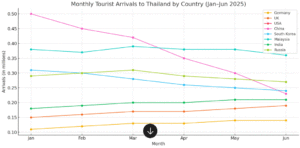CHIANG MAI –ô Facing a notable downturn in international arrivals and shifting traveler behaviors, the Thai government and the Tourism Authority of Thailand (TAT) launched a comprehensive strategy to reboot its tourism sector at this yearãs Thailand Travel Mart Plus (TTM+). Held in Chiang Mai, the event marked the unveiling of the ãThailand Product Update 2025ã, a multi-faceted recovery plan focused on cultural soft power, innovation, safety, and sustainability.
Tourism Decline: Numbers Prompt Urgent Action
Tourism officials sounded the alarm as updated figures showed a consistent decline in foreign arrivals since the pandemic. While Thailand received 35.5 million international tourists in 2024, this remains 11% below pre-COVID levels, compared to 39.9 million in 2019.
The first half of 2025 revealed further troubling trends:
- Chinese arrivals dropped 34% year-on-year (JanãJune 2025), with only 2.27 million visitors, largely due to safety fears following the kidnapping of Chinese actor Wang Xing near the ThaiãMyanmar border. Though the perpetrators were Chinese nationals, the incident made headlines across China and led to widespread cancellations.
- Other East Asian markets also faltered: Japanese arrivals fell by 36%, and South Korea and Hong Kong saw a combined 23% drop in early 2025.
- Vietnam and Malaysia, two key ASEAN sources, also recorded declines of up to 15%.
The Strategic Response: ãAmazing Thailand Grand Tourism & Sports Year 2025ã
In response, TAT presented a visionary roadmap aimed at restoring confidence and repositioning Thailand as a premium, diverse, and safe destination. Core pillars of the plan include:
1. Culture & Soft Power: Exporting the Thai Identity
TAT is investing in what it calls the ã3F Essentialsã ã Flavours, Fabrics, and Fulfilment ã a cultural strategy that promotes:
- Thai gastronomy, traditional textiles, Muay Thai, music, temple art, and cinema.
- Celebrity-led campaigns featuring BLACKPINKãs Lisa, cultural mascots like baby hippo Moo Deng, and internationally recognized Thai artisans.
2. Wellness and Heritage: The Lanna Experience
A renewed focus is being placed on Northern Thai wellness tourism, leveraging Chiang Maiãs ãLannaã legacy. Visitors are offered authentic, immersive experiences:
- Traditional therapies like Tok Sen massage, herbal treatments, and yoga retreats.
- Lanna dance, art, and cuisine as anchors for longer, slower travel.
3. Green Tourism: Building Sustainable Destinations
Thailand now boasts 16 Green Destination-certified areas, including:
- Nan Old Town, Ko Ngai, and Thung Yee Peng village in Krabi.
- The TTM+ event itself was carbon-neutral, reflecting a wider national push for low-carbon tourism models and community-driven experiences.
4. Digital Transformation: Smart Travel Tools
Thailand is modernizing the visitor journey with:
- An improved e-Arrival Card, and relaxed alcohol rules.
- New AI tools such as TAGTHAi app, AR-powered maps, and TATAI, a business intelligence platform for operators.
5. Targeted Campaigns & Safety Protocols
To rebuild Chinese traveler confidence, the ãSawasdee Nihaoã initiative was launched, including:
- Partnerships with influencers (KOLs), short-form video promotions, and Tier-2/3 city outreach in China.
- The introduction of a ãNihao Alertã AI-driven safety app offering real-time alerts on accommodation, transport, and payment systems.
- Nationwide improvements to safety infrastructure and law enforcement presence in key tourism zones.
6. Festivals & Sports: Events as Economic Catalysts
Thailand is tying its recovery to marquee cultural and sporting events:
- Pride Month, Loi Krathong, Phi Ta Khon, and the Phuket Vegetarian Festival.
- International tournaments like the Amazing Thailand Marathon, ONE Championship, and the SEA Games.
These events are designed to boost both arrivals and local spending, while enriching Thailandãs global image.
7. Integrated Entertainment & Regulated Casino Complexes
Thailand is exploring entertainment hubs with:
- Concert arenas, amusement parks, and convention centers.
- A regulated casino segment (limited to ~10%) to attract high-spending travelers and MICE tourism.
These complexes are expected to open in major destinations such as Bangkok, Pattaya, and Phuket.
Looking Ahead: 2025 Targets and Economic Outlook
TAT is aiming for 39 million arrivals and 3 trillion baht in revenue by year-end. The strategy emphasizes not only quantity but quality tourism, focusing on longer stays, higher average spend, and market diversification.
ãWeãre not just inviting the world to visit Thailandãweãre inviting them to feel Thailand,ã said TAT Governor Thapanee Kiatphaibool during the closing session of TTM+.
A New Tourism Era for Thailand
With bold policy shifts, digital reinvention, and a return to its cultural roots, Thailand is charting a fresh course. Whether the nation can regain its pre-pandemic standing hinges on its ability to deliver not just experiencesãbut confidence, consistency, and innovation. (hz)ô

